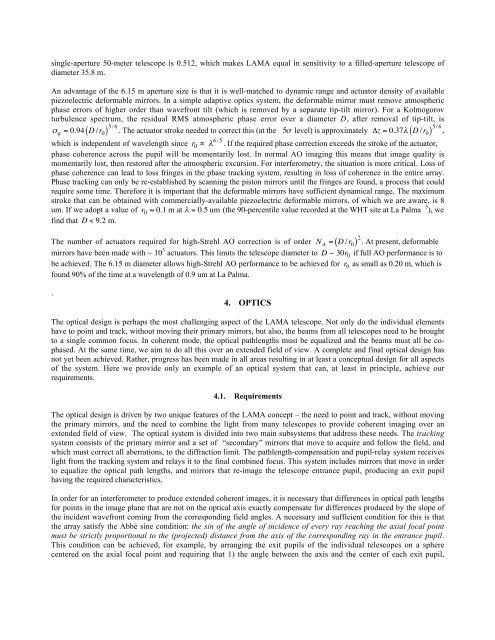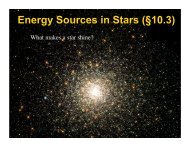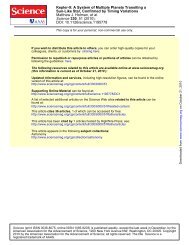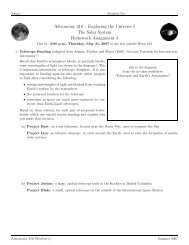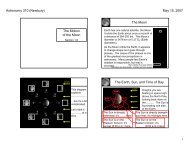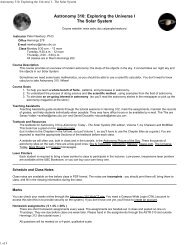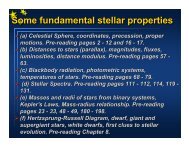Large Aperture Mirror Array (LAMA) - Astronomy and Astrophysics at ...
Large Aperture Mirror Array (LAMA) - Astronomy and Astrophysics at ...
Large Aperture Mirror Array (LAMA) - Astronomy and Astrophysics at ...
You also want an ePaper? Increase the reach of your titles
YUMPU automatically turns print PDFs into web optimized ePapers that Google loves.
single-aperture 50-meter telescope is 0.512, which makes <strong>LAMA</strong> equal in sensitivity to a filled-aperture telescope ofdiameter 35.8 m.†An advantage of the 6.15 m aperture size is th<strong>at</strong> it is well-m<strong>at</strong>ched to dynamic range <strong>and</strong> actu<strong>at</strong>or density of availablepiezoelectric deformable mirrors. In a simple adaptive optics system, the deformable mirror must remove <strong>at</strong>mosphericphase errors of higher order than wavefront tilt (which is removed by a separ<strong>at</strong>e tip-tilt mirror). For a Kolmogorovturbulence spectrum, the residual RMS <strong>at</strong>mospheric phase error over a diameter D, after removal of tip-tilt, iss j = 0.94 ( D /r 0 ) 5 / 6 . The actu<strong>at</strong>or stroke needed to correct this (<strong>at</strong> the 5s level) is approxim<strong>at</strong>ely Dz = 0.37l ( D /r 0 ) 5 / 6 ,which is independent of wavelength since r 0 µ l 6 / 5 . If the required phase correction exceeds the stroke of the actu<strong>at</strong>or,phase coherence across the pupil will be momentarily lost. In normal AO imaging this means th<strong>at</strong> image quality ismomentarily lost, then restored after the <strong>at</strong>mospheric excursion. † For interferometry, the situ<strong>at</strong>ion†is more critical. Loss ofphase coherence can lead to loss fringes in the phase tracking system, resulting in loss of coherence in the entire array.Phase tracking can only be re-established † by scanning the piston mirrors until the fringes are found, a process th<strong>at</strong> couldrequire some time. Therefore it is important th<strong>at</strong> the deformable mirrors have sufficient dynamical range. The maximumstroke th<strong>at</strong> can be obtained with commercially-available piezoelectric deformable mirrors, of which we are aware, is 8um. If we adopt a value of r 0 ª 0.1 m <strong>at</strong> l = 0.5 um (the 90-percentile value recorded <strong>at</strong> the WHT site <strong>at</strong> La Palma 5 ), wefind th<strong>at</strong> D < 9.2 m.( ) 2 . At present, deformableThe number of actu<strong>at</strong>ors†required for high-Strehl AO correction is of order N A = D /r 0† mirrors have been made with ~ 10 3 actu<strong>at</strong>ors. This limits the telescope diameter to D ~ 30r 0 if full AO performance is tobe achieved. The 6.15 m diameter allows high-Strehl AO performance to be achieved for r 0 as small as 0.20 m, which isfound 90% of the time <strong>at</strong> a wavelength of 0.9 um <strong>at</strong> La Palma.††.4. OPTICS†The optical design is perhaps the most challenging aspect of the <strong>LAMA</strong> telescope. Not only do the individual elementshave to point <strong>and</strong> track, without moving their primary mirrors, but also, the beams from all telescopes need to be broughtto a single common focus. In coherent mode, the optical p<strong>at</strong>hlengths must be equalized <strong>and</strong> the beams must all be cophased.At the same time, we aim to do all this over an extended field of view. A complete <strong>and</strong> final optical design hasnot yet been achieved. R<strong>at</strong>her, progress has been made in all areas resulting in <strong>at</strong> least a conceptual design for all aspectsof the system. Here we provide only an example of an optical system th<strong>at</strong> can, <strong>at</strong> least in principle, achieve ourrequirements.4.1. RequirementsThe optical design is driven by two unique fe<strong>at</strong>ures of the <strong>LAMA</strong> concept – the need to point <strong>and</strong> track, without movingthe primary mirrors, <strong>and</strong> the need to combine the light from many telescopes to provide coherent imaging over anextended field of view. The optical system is divided into two main subsystems th<strong>at</strong> address these needs. The trackingsystem consists of the primary mirror <strong>and</strong> a set of “secondary” mirrors th<strong>at</strong> move to acquire <strong>and</strong> follow the field, <strong>and</strong>which must correct all aberr<strong>at</strong>ions, to the diffraction limit. The p<strong>at</strong>hlength-compens<strong>at</strong>ion <strong>and</strong> pupil-relay system receiveslight from the tracking system <strong>and</strong> relays it to the final combined focus. This system includes mirrors th<strong>at</strong> move in orderto equalize the optical p<strong>at</strong>h lengths, <strong>and</strong> mirrors th<strong>at</strong> re-image the telescope entrance pupil, producing an exit pupilhaving the required characteristics.In order for an interferometer to produce extended coherent images, it is necessary th<strong>at</strong> differences in optical p<strong>at</strong>h lengthsfor points in the image plane th<strong>at</strong> are not on the optical axis exactly compens<strong>at</strong>e for differences produced by the slope ofthe incident wavefront coming from the corresponding field angles. A necessary <strong>and</strong> sufficient condition for this is th<strong>at</strong>the array s<strong>at</strong>isfy the Abbé sine condition: the sin of the angle of incidence of every ray reaching the axial focal pointmust be strictly proportional to the (projected) distance from the axis of the corresponding ray in the entrance pupil.This condition can be achieved, for example, by arranging the exit pupils of the individual telescopes on a spherecentered on the axial focal point <strong>and</strong> requiring th<strong>at</strong> 1) the angle between the axis <strong>and</strong> the center of each exit pupil,


